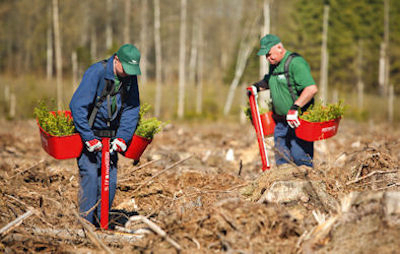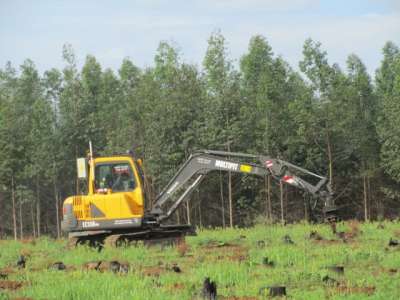Introduction
The regeneration of forest stands using manual methods is labour intensive. Modernisation in forestry, particularly in silviculture, has evolved to enhance efficiency, sustainability, and productivity. Such innovative technology begins with improving the existing manual methods and equipment with more advance tools designed to optimize the planting process. By modifying and enhancing the planting tools and methods, the planting process can achieve set targets while promoting healthier forest ecosystems. Over the past few decades manual planting (manual bending and planting a seedling with a small hand tool) has gradually been replaced by planting tubes and tractor-drawn planters. This article looks at how these methods work and the benefits that come with using these methods.
How the different planting tube configurations work?
a. Planting tube (no irrigation)
Planting tubes create a planting hole by pushing soil to the sides with a pointed pair of hinged jaws. The jaws are switched open with a foot lever, and a container plant is dropped into the hole through the hollow stem tube. The planter then lifts the tube out of the ground, twisting to loosen any soil, and tamps the seedling firmly into the ground with the feet on either side. The jaws are closed by using the release lever. The Pottiputki planting tube is the most popular brand and is available in several models with different tube diameters. In some models, the planting depth is adjustable, which would be necessary for stock types with longer plugs. One attractive benefit of planting tubes is less worker fatigue because the operator does not have to bend over.
Planting with Pottiputki (Pottiputki.com)
b. Planting tube with a separate irrigator
This method of planting comprises of a planter using a planting tube and a separate individual responsible for irrigation during the planting operation. The planter plants seedlings with the planting tool, and the worker responsible for irrigation adds the water (may refer to normal water or hydrogel mix) required into the planting beak during the planting process. In some cases (e.g., sandy soils), soil preparation is performed using the planting tube (modified beak) to create an opening in the soil for planting. The irrigator is also responsible for replenishing the water when required. This type of planting may incorporate the use of a tractor-towed water tank infield or on roadside for the replenishment of water containers used by irrigators.
c. Planting tube with integrated irrigation
The tool comprises of a planting tube tool that is directly connected to a backpack (15-16 litres) which supplies water or hydrogel mix during the planting process. The planter also carries a seedling bucket with seedlings. In this operation, the planter inserts the planting tube beak into the prepared soil. The planter opens the beak only marginally and inserts the seedling into the planting tube. Thereafter, the planter pulls the trigger to allow for the flow of water/gel. The planter observes and releases the trigger once the water/ gel fills the beak. As the beak is pulled out of the soil it must be opened fully to allow the seedling to be left behind. The planter lets go of the left arm, and the tool closes automatically. The operator covers and lightly taps the surface to firm the seedling to remove any air pockets. The backpack is refilled continuously by a designated person who replenishes several planters. Backpack planting tube operations have several renditions; sometimes, the planter carrying the planting tube with the backpack may work with an assistant to carry and supply the seedlings during the planting. The assistance relieves the planter’s overall workload and can improve the overall efficiency.
d. Tractor-trailer with planting tubes
This method of planting combines planting tubes to a self-propelled, tractor-towed, or tractor-mounted water carrier. The planting tubes are all connected to the water supply through a boom system behind the tractor. A team of six planters plant progressively at a steady pace behind the carrier. When planting, about 1.5 – 4 litres of water can be released to each plant through the individual planting tubes. The planter selects a plant and drops it into a tube for planting; thereafter, the planter slightly lifts the tube in a twisting motion and then firms the soil around the seedling with the feet. Planters carry seedlings in a bucket, and replenishment seedlings are stored on the tractor-trailer. One or two workers are usually responsible for replenishing the seedling buckets carried by the planters. Tractor-based planting systems with planting tubes also have several renditions. Standard planting tubes are common; however, some planting tubes can be used to prepare the soil using high-pressure water. The number of planters can be adjusted depending on the boom length and water supply configurations.
Benefits of the different planting tube options:
• Suitable for planting most containerized seedlings (several tube diameters)
• Ergonomically correct working position.
• Less soil disturbance
• Less worker fatigue as the planter does not need to bend
• Tractor-towed planting systems alleviate the need to carry heavy loads (planting gel or water)
Conclusion
Forestry is crucial in maintaining ecological balance, contributing to the economy, and providing raw materials for various industries. As the demand for timber grows, tools need to be developed to enhance the effectiveness of planting operations. Among these innovations, planting tubes, planting tubes with irrigators, and planting tubes integrated into water supply systems pulled by tractors or self-propelled carriers have emerged as vital components in modern forestry practices. Using these methods in modern forestry represents a significant advancement in planting operations. These methods have had a significant impact on planting productivity and cost-effectiveness. Each forestry stakeholder needs to consider their own conditions and select an appropriate method to use.



